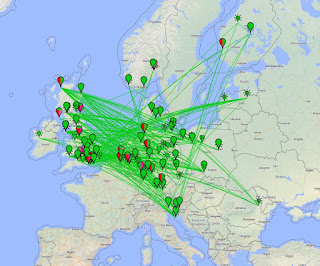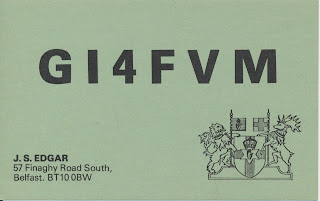I am not really like that. Show me a band full of HF stations ready for a blether and I head for the hills (frequency hills that is, VHF). I do love a bit of white noise to listen to. Now there, for me, is a challenge. I like my weeks of near silence, punctuated by giving away a few points in a contest which I do not enter. It is a thrilling pursuit, or at least for most of the time. Then, to my amazement the bands open and I have to work other stations by the bucket load.
Sure, I love the openings, but there is only so much a man can take. The sound of silence has an allure for me. This week the silence has been shattered.
By the way, this guy (the traditional amateur - I mention) and I have lots to talk about even though we never share the same bands. Let's call him "Gouda" - the cheese making city in The Netherlands. Gouda and I meet often and talk over hot chocolate and filled rolls about the Tour de France, the pathetic collapse of our local amateur radio club, and antenna theory. Antennas are much the same, be they HF or VHF. There is more in common between any two amateurs than what separates them. Sure, we occupy opposite ends of the hobby, but it is the same hobby.
No, Gouda's approach, which gives him great pleasure, is too staid for me. Never mind the ready supply of contacts he has, I love the possibility of what the week ahead might bring. Sure it might be nothing, but sometimes it is lots.
Sometimes I have a week like this past week.
 |
| All stations worked on VHF and 70cms during 7 days ended 27 July 2019 |
I prefer my radio unpredicable.
Despite my hopes for Es, this time of the year usually marks a decline, especially on 70MHz. This week, however, there were several good events. In fact each day was good, but I will only list some events and bands.
22 July - 4m
 |
| 70MHz on 22 July 2019 as seen on dxMaps |
There were two classic 70MHz openings that day:-
 | ||
| OIRT broadcast stations on 22 July at 07:34 |
Lots of broadcast stations, probably from Ukraine and Belarus alerted me to a probable opening to "The East", and my first contact was with SP2MKO (JO93, 1345km) at 07:21. After working OE9KFV on 6m (it is hard to know what to do with strong broadcast competition, and changing to 6m is a good idea unless you then attract Russian TV interference there) I returned to 4m to reach 6xSP, 2xS5, and 9xDL stations plus OK1IN and YL2HA. YL2HA, in KO26 (1671km) being a new square.
That was the end of that opening at 09:22, though the OIRT continued for most of the morning, jumping between stations as ionisation changed.
There was then another opening further to the South starting at 12:38, with S57TW (JN75), and E76C (JN84) worked. Then without much warning, double hop propagation appeared. Single hop is limited to about 2000km, whereas up popped SV2JAO (KN10, 2459km) for a new square on 4m. This is classic Summer Es, and the chances of double hop lasting long are low. SV2JAO was the only double hop of the day, and he faded after the contact and was not heard again. I was still hoping to reach 4X4 on 70MHz, but so far it has eluded me. I suspect it might happen, rather like SV2JAO, briefly and without warning. After HA3GR at 13:23, that was it for 4m on 22 June.
23 QSO (on 4m and 6m), 21 squares, 8 DXCC. Not bad for the end of the season.
25 July 2m and 70cms
With low barometric pressure predicted, about 1010mb, whereas a good tropo opening takes 1026+, I might have thought that not much would happen. However, the Hepburn map (link on sidebar) had been predicting good propagation for several days around then. This was due to an unusual period of slack air and high relative humidity. Sure enough on 25July it happened.
 |
| 2m stations worked at GM4FVM on 25 July 2019 |
As usual nowadays I turned to 70cms...
 |
| 70cms contacts at GM4FVM on 25 July 2019. |
That is now 37 squares on 70cms, in 12 DXCC entities. Interestingly the 70cms ODX was only 14km shorter than the 2m one. And, I was asked again could I try 23cms.
I won't go on ... (much)
This was a very good week but there is no need to go over every contact. What I am trying to show, once again, is what there is plenty to work without the free standing tower and kilowatt linear which some people feel they need. Sure, other weeks are not so good. Enjoy it while it lasts, I say.
On 24 July Cyprus granted access to local amateurs to use 70MHz on an unlimited basis with a 400W output limit. That same day I heard 5B4AIE operating his club station 5B4AIF. I heard him, and PSK reporter confirms that he heard me, but no QSO resulted. Working Asia still is just beyond my grasp on 70MHz. Someday it will happen of course, be it 5B4, 4X4 or some Central Asian state, and once I crack that there will be other challenges.
I work on all the VHF bands available to me, plus 70cms and 28MHz. Not only does this give me an insight into propagation, it means that there is rarely a real lull. Those days I describe with just white noise are not so common when I have five bands to choose from. And I can switch between Es, tropo, meteor scatter, aurora and sometimes even "moonbounce". So there is lots to be done, and weeks like last week are not so uncommon as I might try to pretend.
Maybe I am more like "Gouda" after all. I am getting near the point where I can, like him, just turn on and work somebody somewhere. Not quite though. Almost.
Why, when there are only two or three locals left on VHF, do I insist on giving them names which seem to be straight out of a spy novel? Roland and Gouda. What next? Mata Hari (Margreet MacLeod), ZigZag (Eddie Chapman), or Garbo (Juan Pujol) possibly.
And just to prove you don't need a beam on a tower ...
Not in the same week, but here are a couple contacts using the Sandpiper half wave vertical
 |
| Transatlantic contacts on 6m at GM4FVM on 16 July 2019 |
Don't give up. There is always something to be done even with just a vertical, especially on 4m and 6m.
Actually, there is more than I would have you believe, or even admit to myself.
73
Jim
GM4FVM







